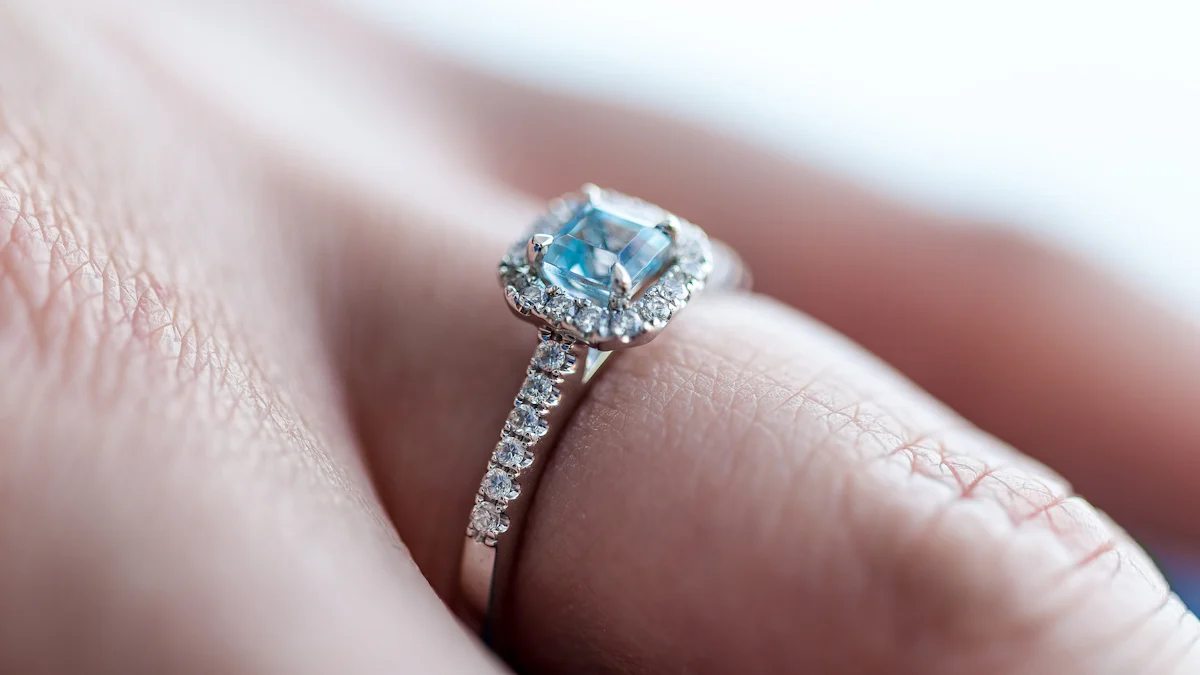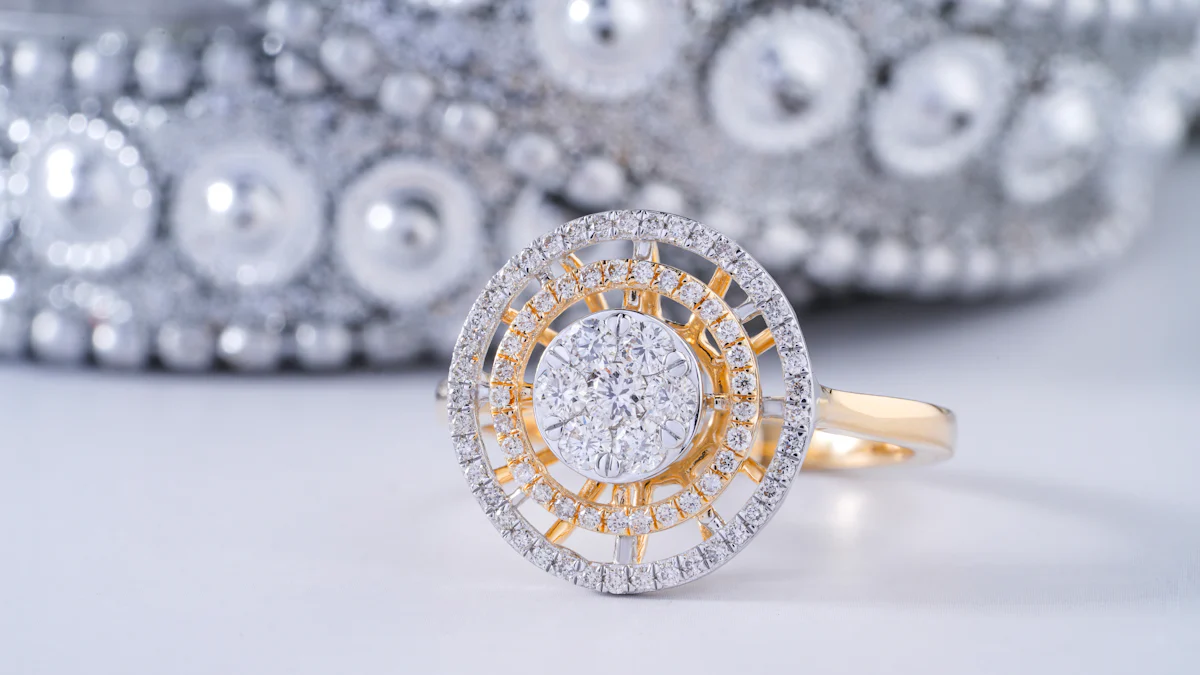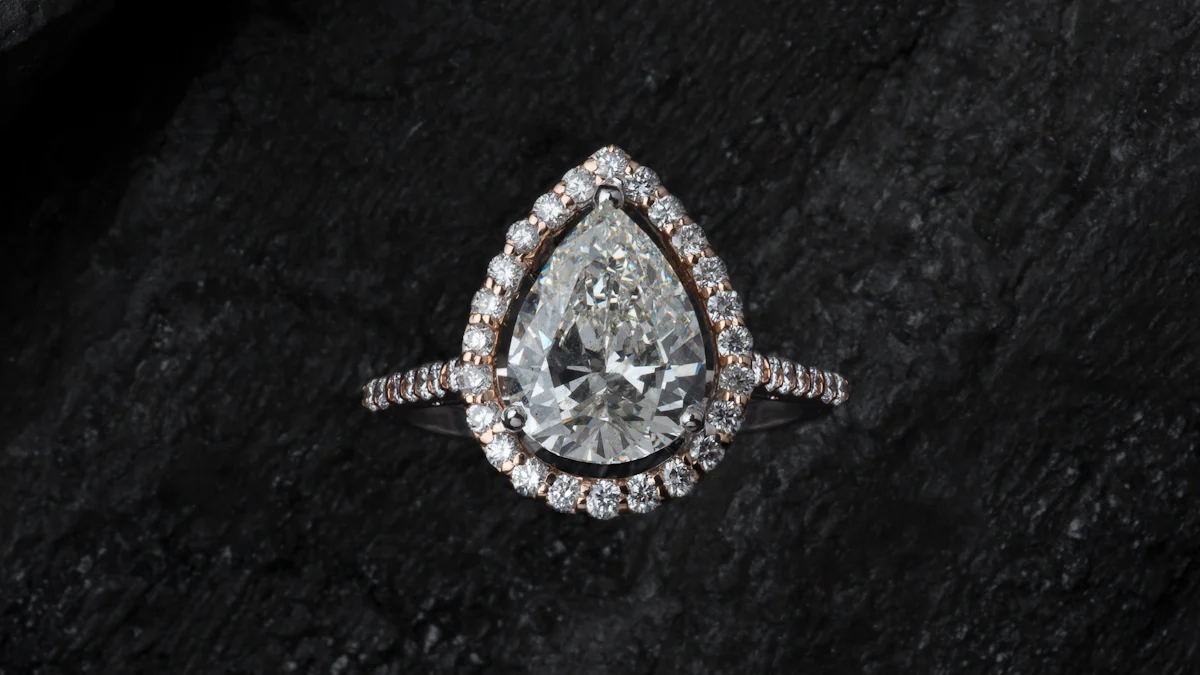How CT TW Diamonds Influence Pricing

Understanding what is a CT TW diamond is crucial when evaluating jewelry. CT TW, or Carat Total Weight, represents the combined weight of all diamonds in a piece. This measurement significantly influences pricing. For instance, a 1-carat center stone with an additional 0.5 CT TW results in a total weight of 1.5 carats. As the total carat weight increases, so does the price, often exponentially. Knowing this helps you make informed decisions, ensuring you get the best value for your investment.
Key Takeaways
- CT TW, or Carat Total Weight, is the combined weight of all diamonds in a piece of jewelry, crucial for understanding its value.
- As the total carat weight increases, the price often rises exponentially, making it essential to consider both CT TW and individual diamond quality.
- When evaluating jewelry, always check the CT TW on the jewelry tag or certificate to assess the overall diamond content.
- Avoid common mistakes in CT TW calculation, such as overlooking smaller diamonds or confusing carat weight with CT TW.
- Ask jewelers specific questions about CT TW, including how it affects pricing and the quality of individual stones, to make informed purchasing decisions.
- Understanding market trends can help you choose jewelry that aligns with your style and offers genuine value, whether you prefer multi-stone pieces or minimalist designs.
Understanding Carat Total Weight (CT TW)

Definition of Carat Total Weight
Carat Total Weight, often abbreviated as CT TW, represents the combined weight of all diamonds in a piece of jewelry. This measurement is crucial when you evaluate multi-stone jewelry pieces. For instance, if you come across a ring labeled as 1/4 CTTW, it means the total weight of all diamonds in that ring equals one-quarter of a carat. Understanding what is a CT TW diamond helps you grasp the overall value and appearance of the jewelry.
Importance of CT TW in Jewelry
How CT TW is Used in Multi-Stone Jewelry
In multi-stone jewelry, CT TW plays a pivotal role. It provides a comprehensive view of the total diamond mass in a piece. When you purchase jewelry with multiple diamonds, the CT TW gives you an idea of the collective weight, which directly influences the piece's price and perceived value. For example, a necklace with several small diamonds might have a CT TW that matches a single larger diamond, yet the visual impact and cost can differ significantly.
Examples of CT TW in Rings and Necklaces
Consider engagement rings and necklaces. A ring might feature a central diamond surrounded by smaller stones. The CT TW includes the weight of all these stones, offering a complete picture of the ring's diamond content. Similarly, in necklaces, CT TW accounts for all diamonds set along the chain or pendant. This measurement ensures you understand what is a CT TW diamond and how it affects the jewelry's allure and cost.
Carat Weight vs. Total Carat Weight
Understanding the difference between carat weight and total carat weight is essential when evaluating diamond jewelry. These terms may sound similar, but they have distinct meanings and implications for pricing.
What is Carat Weight?
Carat weight refers to the weight of a single diamond. It is one of the most critical factors in determining the price of a diamond. Larger diamonds are rarer, which makes them more valuable. As the carat weight increases, the price per carat often rises exponentially. This means that a 2-carat diamond is not just twice as expensive as a 1-carat diamond; it can be significantly more costly due to its rarity and desirability.
How Carat Weight Affects Individual Diamond Pricing
Carat weight directly impacts the price of an individual diamond. Jewelers calculate the price by multiplying the carat weight by the price per carat, which varies based on quality and market demand. For example, a high-quality 1-carat diamond might cost $5,000 per carat, while a 2-carat diamond of the same quality could cost $12,000 per carat. This exponential increase highlights the importance of carat weight in pricing.
Differences Between Carat Weight and Total Carat Weight
While carat weight focuses on a single diamond, total carat weight (CT TW) encompasses the combined weight of all diamonds in a piece of jewelry. This distinction is crucial when you evaluate multi-stone pieces. For instance, a ring with a 0.5-carat center stone and additional smaller stones totaling 0.5 carats would have a CT TW of 1 carat.
Impact on Pricing and Value
The difference between carat weight and total carat weight significantly affects pricing and perceived value. A piece with a high CT TW might seem valuable, but the individual stones' quality and size also matter. Two pieces with the same CT TW can have vastly different prices if one features a larger, higher-quality center stone. Understanding what is a CT TW diamond helps you assess the true value and make informed purchasing decisions.
Calculating CT TW
Methods for Calculating CT TW
Calculating Carat Total Weight (CT TW) involves a straightforward process. You need to sum up the carat weights of all diamonds in a piece of jewelry. This calculation provides the total weight, which is crucial for understanding the overall value of the jewelry. Here's how you can do it:
-
Identify Each Diamond's Carat Weight: Examine the jewelry piece and note the carat weight of each diamond. Jewelers often provide this information on the jewelry tag or certificate.
-
Add the Carat Weights Together: Sum the carat weights of all diamonds. For example, if a ring has three diamonds weighing 0.3, 0.2, and 0.5 carats, the CT TW would be 1.0 carat.
-
Verify with a Jeweler: If you're unsure about your calculations, consult a professional jeweler. They can confirm the CT TW and ensure accuracy.
Understanding these methods helps you accurately assess the total diamond weight in your jewelry, which directly influences its price and value.
Common Mistakes in CT TW Calculation
When calculating CT TW, you might encounter some common pitfalls. Avoiding these mistakes ensures you get an accurate measurement:
-
Overlooking Small Diamonds: You might focus only on the larger stones and ignore smaller ones. Every diamond counts, so include all stones in your calculation.
-
Misreading Carat Weights: Sometimes, carat weights are misread due to unclear labeling or misunderstanding. Double-check the information provided by the jeweler to avoid errors.
-
Confusing Carat Weight with CT TW: Remember, carat weight refers to a single diamond, while CT TW is the total weight of all diamonds. Mixing these terms can lead to incorrect evaluations.
By being aware of these mistakes, you can ensure that your CT TW calculations are precise. This accuracy is vital for making informed decisions about your jewelry purchases.
How CT TW Affects Perceived Value

Influence on Consumer Perception
When you consider purchasing diamond jewelry, understanding what is a CT TW diamond can significantly influence your perception of value. Consumers often equate higher carat total weight with greater worth. This perception stems from the belief that more diamonds or larger stones inherently mean better quality and prestige. However, it's essential to remember that the quality of individual stones also plays a crucial role in determining the overall value. A piece with a high CT TW might seem appealing, but if the diamonds are of lower quality, the perceived value could be misleading.
Survey Results:
- A survey focusing on CTTW revealed that many consumers associate higher total weights with increased value.
- Respondents often overlook the importance of individual stone quality, focusing instead on the combined weight.
Market Trends and CT TW
Market trends also play a significant role in how CT TW affects perceived value. As fashion and consumer preferences evolve, the demand for certain styles and carat weights can shift. For instance, multi-stone pieces with a high CT TW might become more popular during certain periods, driving up their market value. Conversely, trends favoring minimalist designs might lead to a preference for single, high-quality stones over multiple smaller ones.
- Current Trends:
- Multi-stone jewelry with substantial CT TW is gaining popularity, reflecting a trend towards bold, statement pieces.
- Minimalist designs focusing on single, high-quality stones are also in demand, emphasizing the importance of individual carat weight.
Understanding these trends helps you make informed decisions when purchasing diamond jewelry. By considering both the CT TW and the quality of individual stones, you can ensure that you are investing in pieces that align with your personal style and offer genuine value.
Practical Tips for Consumers
When purchasing diamond jewelry, understanding the nuances of Carat Total Weight (CT TW) can significantly enhance your buying experience. Here are some practical tips to help you navigate the world of diamonds with confidence.
Evaluating CT TW When Purchasing Diamonds
-
Examine the Jewelry Tag: Always check the jewelry tag or certificate for the CT TW information. This detail provides the total weight of all diamonds in the piece, helping you assess its overall value.
-
Consider the Quality of Individual Stones: While CT TW gives you the combined weight, the quality of each diamond matters. Look for clarity, color, and cut, as these factors influence the piece's beauty and worth.
-
Compare Similar Pieces: When evaluating different pieces, compare their CT TW and individual stone quality. Two pieces with the same CT TW can have different values based on the quality and size of the diamonds.
-
Understand the Impact on Pricing: Remember that a higher CT TW often leads to a higher price. However, the price also depends on the quality of the diamonds. A piece with a lower CT TW but higher-quality stones might be more valuable.
-
Seek Professional Advice: If you're unsure about the CT TW or the quality of the diamonds, consult a professional jeweler. They can provide insights and help you make an informed decision.
Questions to Ask Jewelers About CT TW
-
What is the CT TW of this piece?: Start by asking for the total carat weight of the jewelry. This question helps you understand the combined weight of all diamonds.
-
How does the CT TW affect the price?: Inquire about how the CT TW influences the pricing of the piece. This information can guide you in evaluating whether the price aligns with the weight and quality of the diamonds.
-
Are there any larger stones included in the CT TW?: Ask if the CT TW includes any significant stones. Larger diamonds can impact the overall appearance and value of the jewelry.
-
Can you explain the quality of the individual diamonds?: Request details about the clarity, color, and cut of each diamond. Understanding these aspects helps you assess the true value beyond just the CT TW.
-
Is the CT TW verified by a third party?: Ensure that the CT TW is verified by a reputable gemological institute. This verification adds credibility to the jeweler's claims and ensures accuracy.
By asking these questions and considering these tips, you can make informed decisions when purchasing diamond jewelry. Understanding the intricacies of CT TW empowers you to choose pieces that offer genuine value and align with your preferences.
Understanding Carat Total Weight (CT TW) is essential for evaluating diamond jewelry. It influences pricing and perceived value. Larger diamonds are rarer and more valuable, making their price per carat significant. When purchasing, consider the balance of carat weight, cut, color, and clarity. This ensures you find a standout piece. Remember, a large center stone often holds more value than multiple smaller stones of equal mass. By grasping these concepts, you can make informed decisions and invest wisely in diamond jewelry.
FAQ
What does CTTW mean in diamond jewelry?
CTTW stands for Carat Total Weight. It represents the combined weight of all diamonds in a piece of jewelry. For example, if a ring has multiple diamonds, CTTW indicates the total weight of these diamonds added together. This measurement helps you understand the overall diamond content in the jewelry.
How does CTTW differ from carat weight?
Carat weight refers to the weight of a single diamond, while CTTW encompasses the total weight of all diamonds in a piece of jewelry. Understanding this difference is crucial when evaluating multi-stone pieces. A ring with a 0.5-carat center stone and additional smaller stones totaling 0.5 carats would have a CTTW of 1 carat.
Does CTTW include gemstones other than diamonds?
No, CTTW specifically refers to the weight of diamonds in a piece of jewelry. If you're interested in a piece that includes other gemstones, like sapphires, the CTTW will not account for their weight. It's important to note that CTTW applies to both natural and lab-made diamonds.
Are CTW and CTTW the same?
Yes, CTW and CTTW are interchangeable terms. Both refer to the total carat weight of all diamonds in a piece of jewelry. You might see either abbreviation used in different contexts, but they convey the same information about the diamond content.
How does CTTW affect the price of jewelry?
CTTW significantly influences the price of diamond jewelry. A higher CTTW usually means a higher price, as it indicates more diamond content. However, the quality of individual diamonds also plays a crucial role in pricing. Two pieces with the same CTTW can have different values based on the quality and size of the diamonds.
Can CTTW be verified by a third party?
Yes, reputable jewelers often have the CTTW verified by a gemological institute. This verification ensures accuracy and adds credibility to the jeweler's claims. When purchasing diamond jewelry, ask if the CTTW has been independently verified to ensure you are getting accurate information.
Why is understanding CTTW important for consumers?
Understanding CTTW helps you make informed decisions when purchasing diamond jewelry. It provides insight into the total diamond content and influences the perceived value and price. By knowing what CTTW represents, you can better evaluate the worth of a piece and ensure it meets your expectations.
Does CTTW affect the visual appeal of jewelry?
Yes, CTTW can impact the visual appeal of jewelry. A higher CTTW might suggest a more substantial or elaborate design, especially in multi-stone pieces. However, the arrangement and quality of the diamonds also contribute to the overall look. Consider both CTTW and design elements when assessing a piece's aesthetic appeal.
How can I ensure I'm getting the best value for my money with CTTW?
To ensure you get the best value, consider both the CTTW and the quality of individual diamonds. Look for clarity, color, and cut, as these factors influence the piece's beauty and worth. Compare similar pieces and seek professional advice if needed. By understanding these aspects, you can make a wise investment in diamond jewelry.
See Also
Exploring Essential Elements That Influence Diamond Ring Costs
Comparative Analysis of Prices for All Around Diamond Rings
Price Comparison of Various Diamond Necklace Designs

